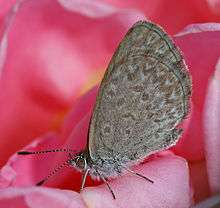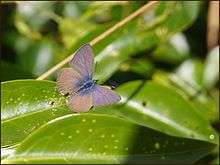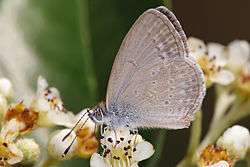Zizina labradus
| Common grass blue | |
|---|---|
 | |
| This specimen, perched on a rose, is approximately 10 mm in size | |
 | |
| At Cape Hillsborough National Park, Australia | |
| Scientific classification | |
| Kingdom: | Animalia |
| Phylum: | Arthropoda |
| Class: | Insecta |
| Order: | Lepidoptera |
| Family: | Lycaenidae |
| Genus: | Zizina |
| Species: | Z. labradus |
| Binomial name | |
| Zizina labradus (Godart, [1824])[1][2] | |
| Subspecies | |
| |
Zizina labradus, the common grass blue, grass blue,[3] or clover blue,[4] is a small Australian butterfly of the Lycaenidae family.
Description

Adults are purplish blue on the upper wing surface with a black body and black or brown wing margins. These margins are larger on the female than the male.[5] The lower wing surface is brown to pale brownish grey with a pattern of fawn bands and spots,[4][6] with the body covered in white or grey hairs. The wingspans of females are slightly larger than males, females having a wingspan of 23 mm and males 20 mm.[5] Common grass blues have a weak, fluttering flight and so usually fly near ground level close to a food source.[5]
Eggs are white or pale blue and have a mandarin shape with a pitted surface.[5] Caterpillars reach about 7 mm in length, and their appearance is primarily green with a yellow stripe at the sides and a darker green stripe on the back, and brown or black head usually obscured under the thorax.[6] In captivity, fed on an artificial diet, larvae come in highly variable colours, ranging from white through red to dark purple.[5] Pupa are 10 mm long with erect hairs. Colouration varies, ranging from pink, greyish or greenish cream and contains mottled dark spots.[5]
Distribution
The subspecies Zizina labradus labradus is found over most of continental Australia, as well as on Lord Howe Island,[6] Norfolk Island, and Christmas Island,[7] while the subspecies Zizina labradus labdalon is restricted mainly to Cape York Peninsula.[6] The common grass blue is often misidentified as the lesser grass blue, Zizina otis.[6]
Zizina labradus labradus, as its name suggests, is very common and can be found in suburban gardens, particularly perching in grass; lawns and fields.[5]
Growth
Single eggs are laid which can hatch in a matter of days.[6] The eggs are laid on leaves, stems, flower buds and young pods of food plants, chiefly legumes of the Fabaceae family such as beans, clover, and various native species.[5][6] Newly hatched larvae eat small holes from young leaves or flower buds, and later feed mainly inside flowers.[5] The larvae are considered a minor pest and will feed on leguminous plants such as garden beans by eating a small hole into the pods and then devouring the soft seeds within.[5] In captivity when food is scarce the larger larvae will cannibalize smaller ones.[5]
The larvae are typically attended by ants of the genera Paratrechina, Rhytidoponera, and Tapinoma.[4]
The pupa attaches to the lower leaf surface of the food plants with anal hooks and a central girdle.[5][6]
References
| Wikispecies has information related to: Zizina labradus |
| Wikimedia Commons has media related to Zizina labradus. |
- ↑ dos Passos, Cyril F. (1958). The dates and authorships of the names proposed in Volume 9 of Encyclopédie Méthodique by Godart and Latreille, 1819-[1824], The Lepidopterists' News 12 (3-4): 119-120.
- ↑ "Butterflies and Moths of the World: Generic Names and their Type-species". Natural History Museum, London, Official Website. The Natural History Museum, London. 2007. Retrieved 2008-07-31.
- ↑ "Bioinformatics: Victorian Butterfly Images". Museum Victoria Official Website. Museum Victoria, Australia. n.d. Retrieved 2008-07-30.
- 1 2 3 "Zizina labradus". Discover nature. James Cook University. 2008-02-04. Retrieved 2008-07-30.
- 1 2 3 4 5 6 7 8 9 10 11 12 Michael F. Braby (2000). Butterflies of Australia, Their Identification, Biology and Distribution, Vol. 2. pp. 837–838. ISBN 0-643-06493-1.
- 1 2 3 4 5 6 7 8 "Zizina labradus". UTS Official Website. University of Technology, Sydney. 2008-06-18. Retrieved 2008-07-30.
- ↑ "Scientific Names: Zizina labradus ssp. labradus (Godart)". CSIRO Official Website (Entomology). CSIRO. 2004-09-19. Retrieved 2008-07-31.